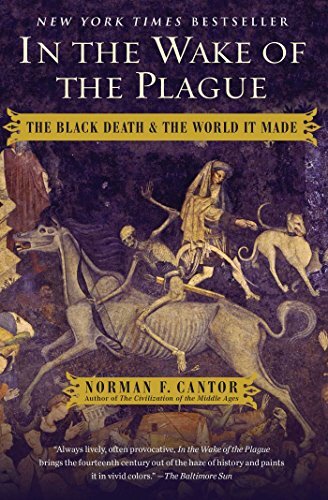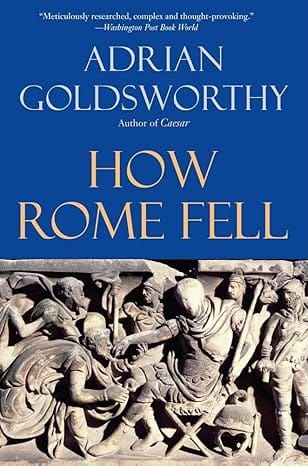The Long View: In the Wake of the Plague
There is a lot of chaos and recrimination now that lots of prominent forecasts of COVID-19 have been publicly revised. However, you shouldn’t fret too much if people can’t get the impact of a major infectious disease correct in the moment; it is entirely possible to screw it up 700 years after the fact too.

In the Wake of the Plague:
The Black Death & the World It Made
By Norman F. Cantor
HarperPerennial, 2002
245 Pages, US$13.95
ISBN 0-06-001434-2
If you know anything at all about medieval European history, you may know that this children’s rhyme preserves a folk memory of the Black Death, the epidemic that swept Europe between 1347 and 1350:
Ring around the rosies
A pocketful of posies
Ashes, Ashes
We all fall down
Unfortunately, if you do know that, you are probably wrong: the rhyme was not recorded until 1881, and may well have been invented in 18th-century America. More unfortunately still, the author of this popular history, the noted medievalist Norman Cantor, begins the book with a meditation on that rhyme, whose connection with the plague he accepts uncritically. The book’s credibility improves little thereafter.
Some of the asides in this book are very disconcerting. For instance, we are told of a ruthless English king whose daughter died of the plague:
Did contemporaries think of Edward III as an evil scourge? Plenty of French peasants did, but among the articulate and literate classes, aside from a handful of radical friars, he was not even considered a tyrant. That term, derived from Roman writers, was reserved for an absolute monarch who ruled without consent of the people. By that definition, Edward III was no tyrant.
[NB I reconstructed this quote from the book, as it was missing from the source file -BIE]
The term is Greek (though the medievals would have encountered it in Latin sources) and refers to a ruler who rules while the constitution is in abeyance. Usurpers might be classed as tyrants, but they were not necessarily unpopular. Maybe he is referring to a special medival use of the term, but if so, it must have been sparingly applied: absolute monarchy was not a medieval institution.
Neither are the author’s dubious assertions confined to the ancient and medieval periods, as we see in this gem about the modern influence of Thomas Aquinas:
“Thomas Aquinas was as learned an intellectual, as powerful a thinker and writer as existed in the medieval world. One segment of his doctrine, on the philosophy of law, endures today in what is called natural law theory and is still embraced by many liberal-minded professors in the better American law schools.”
Judges and law professors who identify themselves as liberals have, for generations, been legal pragmatists of one sort or another. When they teach the history of jurisprudence, they teach that the rejection of the concept of natural law was the predicate for the legal progressivism that is so manifest in their enlightened selves. There are Thomist legal scholars, of course: they are social conservatives.
Readers will learn from this book some things about the Black Death that are probably true. It killed between a third and a half of the population of Europe. In England, with which the author is most familiar, the population did not return until the 18th century to its pre-plague high of about 6 million (a figure it reached in the 13th century, by the way: well before the plague). In any case, the epidemic killed perhaps 40% of the peasants and 25% of the gentry. Men were more likely than women to be affected. The Jews by this time had been expelled from England, but the mortality in the Jewish quarters of Continental cities was generally lower than for the surrounding neighborhoods; this difference helped spark the accusations in Germany that the Black Death was caused by the Jews poisoning the wells.
As the author points out, not only the medievals were confused about the real nature of the Black Death. The conventional view, which is probably more right than wrong, is that the Black Death was bubonic plague, spread by fleas carried in the fur of rats. There are problems with this explanation, however. Many of the descriptions of the Black Death sound as much like anthrax as they do like bubonic plague. The anthrax connection would seem to be supported by the correlation between mortality and association with farm animals. For that matter, it is hard to see how the rats or their fleas could have spread as quickly as the plague did.
And if it was bubonic plague, that leaves us with the question of where it came from. The author suggests the proximate origin was Africa, but then pursues the question of ultimate origins into outer space. He is much taken with Fred Hoyle and Chandra Wickramasinghe’s panspermia hypothesis, which has it that life originated in space (or at least drifts through space to habitable planets). Later visitations of these extraterrestrial microorganisms sometimes become terrestrial diseases. I suggest that this would be easier to believe of viruses than of bacilli, but at least the hypothesis is testable: samples from a comet are being tested even as I write this.
Less testable is the effect that the Black Death had on European history; least testable of all is its effect on the cultural climate. Why so? Well, for one thing, the effect of climate in the literal sense is also an issue. The end of the 13th century was also the end of a warm spell in the climate of Europe, when summers were long and the winters mild. By the time the Black Death arrived, Europe had already seen 50 years of sporadic bad harvests and occasional famines.
If we are to believe Cantor, Europe around 1300 was a reasonably genial place:
“Steeped in art, poetry, and music, and decorated with expensive plate armor and the latest silk clothes in the Milanese or Parisian mode, this aristocratic, very rich people’s respect for the king and his family became the behavioral pattern and sensibility called chivalry.”
Well before the Black Death, however, politics and society were becoming appreciably nastier:
“The dispossessed King Edward II was killed [in 1327] by a red-hot iron poker shoved up his anus. This savagery partly reflected hostility on the part of the Church and other opinion-makers to the king’s homosexuality and his favoritism toward his young French male lover, but it also reflected the general malaise, anger, and pessimism of the new age of global cooling.”
This conclusion goes beyond the evidence, perhaps.
One would not quarrel with the author’s assessment that the “century after the Black Death was marked – in England, France, the low countries, and Germany – by what may be called the privatization of medieval Christianity.” It is also true that the “mid-fourteenth century was the beginning of the age of the witchcraft delusion that consumed western Europe for another 400 years.” Europe in 1400 was a more macabre place than in 1300. The Dance of Death became a common artistic motif, and people thoughts turned to the End Times. Still, the author’s characterization of the mind of the 13th century was, frankly, new to me. He tells us that there was an “almost universal belief that Christendom was on a direct route to ever happier days culminating in the second coming of Christ, which was only postponed until all peoples of the earth joined the Church.” The only notable pessimists were the small and eccentric minority influenced by the late 12th-century abbot, Joachim of Fiore. In Cantor’s account, indeed, the cheerful High Medieval period seems to have precociously anticipated 19th-century postmillennialism. This view is open to criticism.
Nothing daunted, the author multiplies ways in which the 13th century was like the 19th in being an optimistic century that preceded a catastrophic one. However, he finds fault with the medievals:
“Europe of the nineteenth century, at least the second half, invested heavily in scientific research… Thirteen century Europe, aside from research on optics, which led to the introduction of eyeglasses, and improvement in mechanical clocks, made no scientific progress.”
Their most important negligence was the failure to pursue biomedical research. Cantor makes bold to say “[t]he Black Death did not create the dance of death…the causality ran the other way.” In other words, the turning that began around 1300 of intellectual life to morbid and otherwordly concerns made Europe less able to cope with the epidemic and its aftermath. This conjecture follows from his admiration for medieval nominalism and his disparagement of the increasingly influential Thomism, at least to the extent that these schools served as philosophies of science. He tells us, “The Black Death helped to make apparent that Thomism was an intellectual dead end.”
Cantor is a particular fan of the Oxford Occamist, Thomas Bradwardine, who was archbishop of Canterbury for just a few weeks before succumbing to the Black Dearth in 1349:
“His theory that space was an infinite void in which God could have created other worlds had revolutionary implications… Bradwardine did not develop the implications of his theory, probably because they would have struck at the center of medieval religion and moral beliefs. He was content to leave his theory in its astrophysical and less controversial form… If the Black Death had not struck down the new Archbishop would the outcome have been different?”
One may doubt Cantor’s assessment of what Bradwardine’s ideas might have meant to his contemporaries: it sounds a little like the attempts to read the controversy over Victorian Darwinism back into Galileo’s advocacy of heliocentrism. On the other hand, Cantor is half right when he notes this about the metaphysics of William of Occam and his school:
“This is close to the modern position enunciated by Immanuel Kant around 1795…Thus the Oxford approach of the early fourteenth century led ultimately to the modern scientific world.”
The half that’s wrong is the one that connects Kant to the development of modern science. The tradition that flows most directly from Kant leads from Hegel to Nietzsche to Heidegger to the postmodernists. If anything, its effect has been antiscientific. There is a direct connection between Kant and the modern philosophy of science, and particularly to analytical philosophy. The problem is, though, that the philosophers of science have spent over a century honing their logical tools to an exquisite sharpness, but actual scientists have never had much use for them. Indeed, one might argue that science could not have developed in an environment in which analytical philosophy predominated, because it encourages skepticism about the power of mathematics.
Certainly Aquinas’s assumption of the validity of Aristotelian physics was not helpful to the development of science, but his “moderate Realism” probably was. (This is the notion that ideas do exist, but that we can know them only through the senses.) The embarrassing thing about the history of science, however, is that the most helpful philosophy of all, at least with regard to physics, is probably the neoplatonism, even hermeticism, that we find in the worldviews of such people as Newton and Max Planck. The author does suggest less speculative ways in which the great epidemic shaped the later world. For instance, the sudden disappearance of such a large fraction of the landowning class, and an even larger fraction of the class that worked the land, certainly accelerated the development in England of the law of real property:
“Its principles and procedures were worked out empirically by the English bar in the fourteenth century, given a big boost by the carnage and confusion visited upon gentry families by the Black Death… American law students in their first-year course on property law are today imbibing a judicial heritage crystallized in Black Death England and the culture of contention and merciless conflict imbedded in the common law.”
As we have noted, rumors circulated that the Black Death was caused by Jews poisoning the wells, and these rumors led to massacres. Nobody comes off very well in the author’s account (except perhaps Pope Clement VI, who at least managed to prevent a massacre at the papal seat at Avignon). Among those who don’t come off well are the rabbis of Germany and France, whom Cantor suggests might have been able to deal better with the emergency if they had not abandoned the stolid Aristotelianism of Maimonidies for the esotericism of the Kabbalah. In any case, the Jewish survivors of the disorders incident to the plague were often expelled from their homes, but they did find a welcome farther east:
“The rise of the great Jewish communities in Slavic Europe, remarkable for their enterprise and traditional learning, and also innovation in religious and literary expression, was a direct result of the Black Death.”
That sounds reasonable. It might even be true. Several other statements in this book are no doubt true, too. The volume includes a fine critical biography. This is very useful, because so little of the text should be trusted.
Copyright © 2006 by John J. Reilly
Support the Long View re-posting project by downloading Brave browser, and then trying it out. With Both Hands is a verified Brave publisher, you can leave me a tip too!



Comments ()